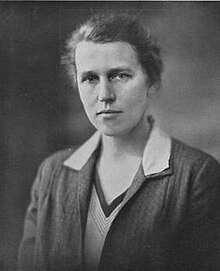Hilda Worthington Smith
| Hilda (Jane) Worthington Smith | |
|---|---|
 |
|
| Born |
June 19, 1888 New York City |
| Died | March 3, 1984 (aged 95) |
| Nationality | American |
| Occupation | educator |
| Known for | Bryn Mawr Summer School for Women Workers in Industry/She-She-She Camps/Worker Education |
Hilda Worthington Smith (June 19, 1888 – March 3, 1984) was an American labor educator, social worker, and poet. She is best known for her roles as first Director of the Bryn Mawr Summer School for Women Workers in Industry and as a co-founder of the Affiliated Schools for Workers (later known as the American Labor Education Service), though she also had a long career in government service supporting education for underserved groups including women, labor workers, and the elderly.
Worthington Smith was born in 1888 in New York City. Her father's invention of a steamheating system, which heated many of the early office buildings of New York, provided the family with a plush fortune. She attended Bryn Mawr College between 1906 and 1910 for her undergraduate degree, during which she was elected to lead the student body as president of the Self Government Association. Worthington Smith remained at Bryn Mawr the following year and left in 1911 with a master's degree in ethics and psychology, after which she received a second graduate degree from the New York School of Philanthropy (which exists currently as the Columbia University School of Social Work). When she was twenty-five years old she returned to Bryn Mawr at the invitation of President of the College, M. Carey Thomas, to oversee a residence hall as a Warden (p. 42), and began to teach an informal class on social work at the request of a group of undergraduates in which she introduced the concepts of child welfare, family rehabilitation, delinquency, immigration, and housing. (p. 44). She returned to her studies at the School of Philanthropy in 1914 and soon established a community center for youth in New York City that served many boys of Irish, Italian, and African American descent, which she ran until M. Carey Thomas offered her the position of Acting Dean in 1919. In the two years that she served as Dean, her interest in workers' education was already becoming an area of active pursuit: in addition to her duties mentoring undergraduate students and administering college programs, Smith took the initiative to arrange night classes for the black college gardeners and service employees (p. 16).
A pivotal moment in Worthington Smith's career came in 1921, when President Thomas asked her to head the Bryn Mawr Summer School for Women Workers in Industry, a brand new initiative that Thomas envisioned and set into motion after visiting Workers' Educational Association programs in England. Though Thomas was the original visionary of the school, Worthington Smith is credited with developing it into the immensely successful program that it became and setting the example for a host of other similar programs that were founded in its image, including the Wisconsin Summer School, Barnard Summer School, Vineyard Shore School, Southern Summer School, and the coeducational Hudson Shore Labor School. The Summer School was a residential program on the campus of Bryn Mawr College that operated for 8 weeks in the summer every year (except for 1935) between 1921 and 1938, hosting and educating female factory workers from all over the country who numbered approximately 1700 over the duration of the initiative. Money was raised for scholarships to support the students, who were between the ages of 18 and 35 and came from diverse backgrounds including different nationalities, races, religions, industries, non-unionized and union affiliations. About 100 women attended each year that the school operated, gathering to live, eat, and sleep together while they studied a variety of liberal arts subjects with distinguished faculty drawn from local institutions.
...
Wikipedia
